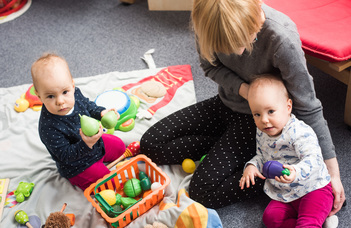How do babies familiarize themselves with the social world?

The primary goal of Babylab is to explore the processes of social cognition. How do babies start to understand the social world around them during the course of development?
Did you understand it the same way as I did?
In recent years, there have been several experimental findings suggesting the early existence of high-level cognitive functions. These include understanding others’ beliefs (also known as theory of mind) as early as 7 months of age, or the brain wave called N400 at 9 months of age, which indicates word processing. In our current research, during which babies witness a puppet show-like scenario, we use a special instrument, which measures the weak brain signals of babies, to explore the relationship that may exist between language and the development of theory of mind. Our preliminary experimental results suggest that in the presence of another person, even in the case of 14-month-old babies, a brain activation is apparent that suggests that they are processing speech from the other person’s point of view. Although the results are very promising, further thorough investigation is required. We are doing these experiments at present. (Autumn of 2022)
Learning while playing
Children spend most of their time playing. Playing can involve discovering things while exploring the environment, while other games are more about making up rules together. In the latter, objects may have invented functions during play: For example, building blocks are soaps for washing hands. In order to acquire proper knowledge of the world, children need to be able to distinguish between invented properties (which are valid only within the game) and "real" properties (which may be valid outside the game).
In our study, children and two colleagues play with invented and familiar objects. Some games involve rules that are part of our cultural knowledge (for example, a key opens a padlock). Others involve novel information children can learn (for example, a key can rattle a box). Children encounter this novel information in two contexts: In one case, they find out that the box rattles in this way. That is, they witness the consequences of the rattling action in reality. In another case, the rattling is part of a fictional game that can only be imagined jointly by the child and the experimenter. During the game, one experimenter is present all the time. While the other is absent when children encounter the novel information.
We wonder whether, when the second experimenter sits down at the table and initiates a game, children consider if the novel information was "real" or just part of a made-up game. We assume that the 3-year-olds can distinguish between the two kinds of events. And in the fictional situation, the joining adult is presented with the culturally familiar prop. While in the "real" situation, children give the prop of the novel game to the adult.
Our study is currently underway in the 3-year-old age group. (Summer of 2023)
